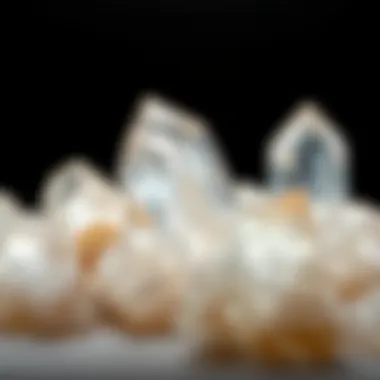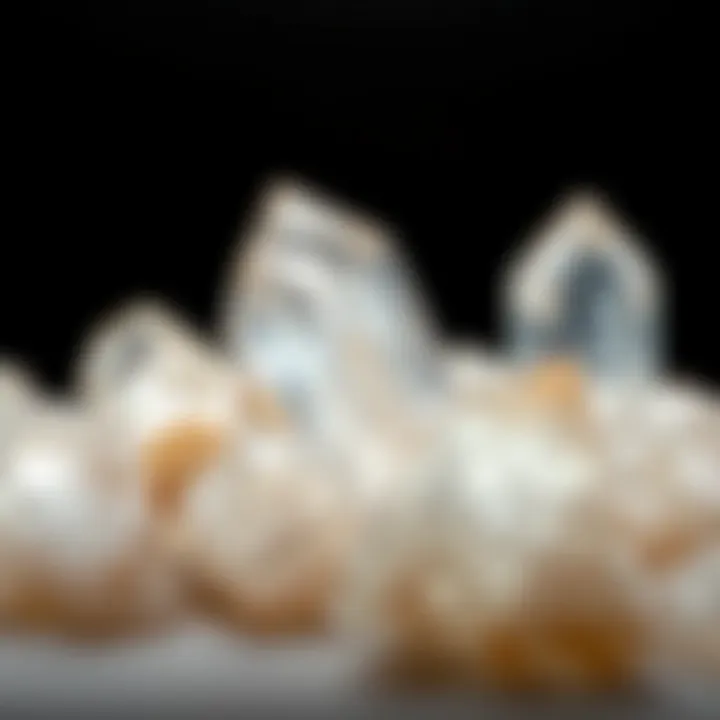Exploring Quartz Bulk: Properties and Applications


Intro
Quartz is an abundant mineral that has captivated humankind for ages. Known for its clarity and versatility, quartz stands tall in various fields, from electronics to jewelry crafting. Understanding quartz bulk requires a deeper look into its properties, origins, and applications. This article aims to shed light on why quartz matters, both in nature and industry.
History and Origins
Overview of Collectibles, Rocks, and Fossils
The allure of quartz dates back to prehistoric times when it was one of the first stones used by early humans for tools and ornaments. Its durability and wide availability made it a prized possession in the realm of collectibles. The mineral's varying colors and textures have given rise to many forms, all perfectly poised to tantalize the eye.
During the Stone Age, quartz was not just a rock; it was a vital resource. People crafted tools out of quartz crystals, shaping them into knives and scrapers. Today, many rock and fossil collectors hunt for unique quartz specimens, making this mineral a favorite in both casual and serious collections.
Historical Significance and Cultural Impact
Throughout history, different cultures have revered quartz as a symbol of clarity and purity. In ancient Egypt, it was believed that quartz could filter out negative energy and guard against illness. In various indigenous cultures, quartz was used in rituals and believed to hold spiritual powers. Such beliefs have contributed to making quartz a cultural gemstone, often found in ceremonial items.
Not only in ancient times but even today, quartz retains its significance. Modern art and architecture often utilize quartz for its aesthetic appeal. Combined with practical properties, it continues to inspire artists and builders alike.
Identification and Classification
Guide to Identifying Rocks and Fossils
To the untrained eye, identifying quartz might seem straightforward, yet its variations can be tricky. Collectors often look for key characteristics:
- Color: Varies widely, from clear to smoky, pink to amethyst. Each hue can signify specific impurities within the quartz.
- Formation: Crystals can be found in various forms, including drusy, massive, and banded structures.
- Transparency: Most quartz is translucent to transparent, making it distinct from other minerals.
Common Types and Variations
Quartz can be classified into several types, each with unique attributes:
- Clear Quartz: Often referred to as rock crystal, this type is prized for its clarity and is used in everything from watches to crystal healing.
- Amethyst: A purple variant, celebrated for its beauty and used in fine jewelry.
- Citrine: Yellow to orange in color, often seen as a stone of prosperity.
- Rose Quartz: Known for its soft pink hue, ideal in decorative objects and jewelry.
Quartz is not just a rock; it’s a tapestry woven through human history, culture, and the very earth we stand on.
As we delve deeper into the properties and applications of quartz, we unravel the myriad ways this remarkable mineral has influenced both science and society. For collectors, understanding these details enriches the experience of owning pieces of the earth's history.
Prolusion to Quartz Bulk
Understanding quartz bulk is akin to grasping the building blocks of not just the Earth’s crust, but also a myriad of industrial applications and historical significances. Quartz is one of the most abundant minerals found on our planet, and its properties make it a crucial element in various fields including electronics, construction, and even jewelry. When we talk about quartz bulk, we’re not merely discussing a mineral; we’re delving into a substance that has shaped landscapes and influenced industries for centuries.
Definition and Overview
Quartz, scientifically known as silicon dioxide (SiO2), is a hard and crystalline mineral. Its structure is characterized by a three-dimensional arrangement of silicon and oxygen atoms. Found in many forms and colors, quartz can appear as clear crystals or in shades of purple, pink, and brown. In its bulk form, it is typically mined and processed for various uses.
One of the primary reasons for the importance of quartz bulk lies in its physical properties. Quartz is noted for its durability and chemical inertness, meaning it does not readily react with other substances. This stability makes it an ideal candidate for various industrial applications where other materials might fail. When we consider its role as a gemstone, quartz also holds aesthetic appeal, captivating collectors and jewelers alike.
Historical Context
The history of quartz spans back millions of years and is interwoven with human civilization. Ancient tools made from quartz date back to the Stone Age, illustrating its crucial role in early human life. Early human ancestors utilized quartz for making tools and weapons, paving the way for advances in technology and skill.
Throughout various ancient civilizations, quartz held symbolic meanings. The Egyptians revered it for its supposed purity and believed it could promote clarity of thought. In contrast, cultures like the Greeks associated quartz with divine properties, using it in rituals and as a talisman.
In modern times, the value of quartz has only increased, thanks to its application in technology and various industries. For those who collect rocks and fossils, quartz not only serves as a bridge to the past but also remains a relevant material that influences contemporary practices.
"Quartz is more than just a mineral; it is a storyline that connects the past, present, and future of our planet."
In summary, understanding quartz bulk provides valuable insights into its defining attributes, applications, and rich history, setting the stage for deeper explorations into its geological formation, properties, and significance in today’s world.
Geological Formation of Quartz
Understanding the geological formation of quartz is vital as it lays the foundational knowledge for appreciating its prevalent role in various applications. Essentially, quartz is one of the most abundant minerals in the Earth's crust, and its formation process indicates much about Earth's history and geological processes. By exploring how quartz forms, we can better grasp its diverse properties and how these features support its widespread use in industries and art alike.
Formation Processes


Quartz typically forms through two primary processes: magmatic and sedimentary. In magmatic environments, quartz crystallizes from molten rock as it cools, resulting in well-defined crystals found in igneous rocks. The rate of cooling significantly affects the size and clarity of these crystals. Fast cooling leads to small or no crystal formation, while slow cooling allows larger, clearer crystals to develop.
In sedimentary environments, quartz often results from the breakdown of existing rocks. Over time, weathering breaks down feldspar, mica, and other minerals, leaving quartz grains relatively unaffected due to its chemical stability. These grains then accumulate as sand or silt, compacting over time into sedimentary rocks like sandstone, wherein quartz can comprise up to 90% of the rock composition.
"Every quartz crystal has a story to tell, shaped by the conditions of its environment, the elements it interacted with, and the time it spent forming."
The distinctive hexagonal crystal structure of quartz, observable under various light conditions, comes from these processes, making each crystal unique. During periods of volcanic activity, quartz can also form from high-temperature solutions, contributing to its varied occurrences in different geological formations.
Types of Quartz Deposits
Quartz deposits can be classified into several types, each holding specific characteristics valuable for different applications:
- Primary Deposits: Found in igneous rocks. They form directly from molten rock and tend to be rich in high-quality crystals. These naturally formed clusters can serve various purposes, particularly in jewelry making and scientific applications.
- Secondary Deposits: These are typically alluvial or in sedimentary contexts, where quartz has been weathered from primary sources and transported by natural forces like water. This transportation can result in rounded and worn-down grains that are perfect for use in construction or as sand in industrial applications.
- Hydrothermal Deposits: Formed from mineral-laden waters, hydrothermal deposits can occur in veins within rocks, showing distinct layering or banding. They are often sought after for high-purity quartz, routinely used in electronics and more refined industrial processes.
- Vein Quartz: This specific type of quartz forms in fissures or cracks in other rocks. It’s typically associated with gold or other minerals, highlighting its economic importance. Miners often seek vein quartz due to the potential for extracting valuable metals in tandem.
Each deposit type brings unique qualities and characteristics that reflect geological conditions. Recognizing these differences helps rock and fossil collectors understand quartz's role in their collections and the broader geological narrative.
In summary, the geological formation processes and types of quartz deposits significantly influence its physical properties, applications, and cultural significance. By understanding these aspects, one can better appreciate the value and presence of quartz in natural and industrial landscapes alike. For further insights into geological principles, consider visiting Britannica or Wikipedia.
Physical Properties of Quartz
Understanding the physical properties of quartz bulk is paramount for anyone engaged in geology, material science, or related fields. These properties not only inform us about the formation and classification of quartz but also influence its applications across various industries. The significance of studying quartz is underscored by its ubiquity, resilience, and versatility.
Crystal Structure
Quartz crystallizes in the trigonal crystal system and typically forms hexagonal prisms that can vary in size and clarity. The arrangement of silicon and oxygen atoms in quartz creates a framework that is both strong and durable. Each silicon atom is surrounded by four oxygen atoms, leading to the formation of a three-dimensional network crystal structure. This unique structure contributes to quartz’s remarkable hardness, rated at a solid 7 on the Mohs scale.
Proper identification of the crystal form can distinguish between high-quality quartz and its less desirable counterparts. For enthusiasts and collectors, finding specimens with well-defined crystals is a point of pride. Moreover, due to its crystalline nature, quartz has excellent clarity and a striking array of colors, influenced by various inclusions and impurities, such as iron or titanium. This characteristic is essential in geology as specific formations can signal particular environmental conditions.
“The beauty of quartz is not just in its colors but in tales it tells about Earth’s journey through time.”
Optical Characteristics
Quartz’s optical properties are of immense interest, especially in technological fields. It exhibits double refraction, meaning that a ray of light entering quartz splits into two rays, producing a unique optical phenomenon. This quality is especially useful in optical instruments, enhancing precision in devices such as microscopes and polarized glasses. Furthermore, the transparency of quartz ranges from completely clear to varying shades, which is pivotal not only for aesthetic purposes but also for scientific applications.
The conchoidal fracture present in quartz makes it particularly valuable for lapidary uses, as this fracture allows for a smooth surface, perfect for gemstone cutting. The optical properties can also help in analyzing the physical history of the quartz, with color zones and inclusions often marking past geological events. Collectors should keep an eye out for quartz with unusual optical traits, as these specimens can be both rare and fascinating.
Chemical Properties
Chemically, quartz is primarily composed of silicon dioxide (SiO2). This simplicity belies its significance in various chemical processes. Quartz is generally inert, showing very little reactivity, which makes it a preferred material in laboratory settings and manufacturing environments. Its resistance to chemical weathering signifies its longevity in the natural environment, hence its abundance in sedimentary deposits.
Furthermore, the doping of quartz with metals can enhance its properties, leading to variations like amethyst or citrine, adding layers of intrigue for collectors. The chemical stability of quartz positions it as a foundational component in various industrial applications, from glass-making to semiconductor fabrication. Understanding the chemical underpinnings enables one to appreciate the broad spectrum of quartz varieties and their utility.
In summary, the physical properties of quartz offer a window into its significance, not just as a mineral but as a vital resource across various fields. Collectors, geologists, and industrialists alike must admire these characteristics to fully appreciate what quartz represents: both Earth’s past and future possibilities.
Applications of Quartz Bulk
The diverse applications of quartz bulk showcase its significance across various sectors, underlining its multifaceted nature and essential role in both industry and daily life. As a natural resource, quartz is not just abundant; it's also remarkably versatile, which makes it integral in numerous products and technologies that we often take for granted. Understanding its applications can aid in appreciating its value beyond mere aesthetics or geological interest. In this section, we’ll explore how quartz bulk finds its footing in industrial settings, technology, jewelry, and ornamental crafts.
Industrial Uses
Quartz boasts a plethora of industrial applications, primarily due to its physical and chemical properties. The mineral's hardness and resistance to chemical weathering make it a prime choice in industries like construction and manufacturing. For instance, crushed quartz is often used in concrete, mortar, and as a component in glass-making. Furthermore, the use of quartz sand in hydraulic fracturing— or "fracking"— is a revelation, as this particular application skyrockets its demand in energy sectors.
- Silica sand production: Quartz, in its sand form, plays a crucial role in the creation of silicone products, vital for various applications like electronics.
- Foundry applications: Used for molding materials, quartz’s high melting point and thermal stability render it ideal for foundries.
- Ceramics and composites: In the ceramics industry, quartz acts as a key ingredient for producing highly durable surfaces and products like tiles and pots.
Electronics and Technology
In the realm of electronics, quartz plays an indispensable role, especially in the production of oscillators and frequency control devices. Quartz crystals are utilized to produce precise frequencies that are essential for communication devices, including smartphones, radios, and computers.
- Quartz resonators: These devices, made from quartz crystals, are crucial in ensuring reliable performance in a myriad of electronic gadgets. They stabilize frequencies, which is vital for accurate functioning.
- Optoelectronic components: Quartz also finds a home in lasers and optical devices— its optical clarity enhances light transmission, making it integral in advanced optics.
- Surface acoustic wave (SAW) devices: These devices depend on quartz’s properties for filters in various applications from telecommunications to sensor systems.
Jewelry and Ornamentation
In the realm of aesthetics, quartz has mesmerized cultures for centuries. Its wide array of colors and forms has made it a popular choice among jewelry makers and artisans. From amethyst to citrine, quartz varieties lend themselves to a stunning display of craftsmanship and beauty.
- Gemstone displays: The beauty of quartz, employed in rings, necklaces, and bracelets, is not just skin deep; it is often associated with specific meanings and powers in different cultures.
- Home decor and ornamentation: Beyond personal adornments, quartz is also embraced in home decor— from lamp bases to unique sculptures, its beauty transforms living spaces.
- Spiritual and healing practices: Many cultures regard quartz as a healing stone, believed to carry various energy properties, contributing to its use in meditation and wellness practices.


"Quartz is not only the most abundant mineral on Earth's surface, but its utility across various sectors showcases its potential far beyond mere geological curiosity."
For further reading, consider exploring these resources on the applications of quartz:
- Wikipedia on Quartz
- Britannica on Quartz
- ResearchGate for academic papers on quartz applications.
Quartz in Construction and Architecture
Quartz bulk plays a pivotal role in the construction and architectural sectors, serving as both a functional material and an aesthetic enhancer. This versatility of quartz is not merely a matter of preference; it’s deeply entrenched in its unique physical and chemical properties, which make it suitable for various applications. Its durability, resistance to weathering, and ease of maintenance offer concrete advantages when integrated into building projects, while its aesthetic potential adds significant value to design and architecture.
Building Materials
In the realm of building materials, quartz is often tapped in the form of aggregates for concrete, ensuring that structures are both strong and resilient. The crystalline nature of quartz lends itself well to blend with cement, augmenting its longevity. Here are some specific kinds of materials made from quartz:
- Quartzite: This naturally occurring stone is known for its durability and is often used for countertops, flooring, and even façades. Its ability to withstand harsh weather conditions makes it a favorite for outdoor applications.
- Silica Sand: Used as a foundational layer in many construction projects, silica sand made from quartz is essential for concrete production, providing stability and strength.
- Engineered Stone: Comprising a mix of crushed quartz and resins, engineered stone surfaces, like those found in kitchens and bathrooms, offer an appealing blend of functionality and style. Their non-porous nature ensures that spills and stains don’t become a headache for homeowners.
The use of quartz-enhanced materials directly reflects the industry's push towards durability. Materials that can weather the passage of time, while also meeting aesthetic desires, are in high demand. Moreover, many of these quartz-based materials come with a lower environmental impact when sourced locally, making them not only a practical but an eco-friendly choice as well.
Aesthetic Contributions
When it comes to the aesthetic contributions of quartz, the implications extend beyond mere appearance. Quartz can be beautifully transparent or exhibit a wide range of colors depending on its impurities. This variability is a boon for architects and designers looking to incorporate natural beauty into their plans. Here are the many ways quartz contributes aesthetically:
- Variety of Finishes: From polished to honed textures, quartz surfaces can take on various finishes, making them suitable for different design themes, whether modern or traditional.
- Natural Veining: The inherent patterns found in quartz can add a unique touch to spaces such as kitchens, bathrooms, and living areas, ensuring that no two surfaces are identical.
- Integration with Other Materials: Quartz complements other materials like wood, steel, or glass, perfecting that fine balance of nature and modern construction. This versatility gives designers the freedom to explore options that resonate with their vision.
"Quartz doesn’t just meet the need for sturdiness; it acts as a canvas that advantages creativity and expression in architecture."
Ultimately, the infusion of quartz into construction and architecture brings both strength and beauty into homes and buildings. As the world shifts towards sustainable practices, the focus on quartz as a primary material is likely to grow, capturing the attention of architects, builders, and homeowners alike.
The Geological Importance of Quartz
Quartz plays a vital role in understanding both the Earth's history and its present conditions. This mineral is not just one of the most abundant elements found in the Earth's crust; it serves as a crucial indicator in many geological processes. By examining quartz, geologists can glean insights into the composition of the Earth, the processes that have shaped its surface, and the environmental changes that may have occurred over time. The study of this mineral fosters a deeper appreciation for our planet's dynamic systems, highlighting its relevance in both geology and environmental science.
Role in Geological Surveys
In geological surveys, quartz is a prominent feature due to its resilience and abundance. Its presence in various rock formations helps geologists determine the type and age of rocks, which is essential for understanding Earth's stratigraphy.
- Rock Type Identification: Quartz-rich rocks like granite or sandstone hold clues about their geological history. For instance, finding quartz in certain strata can indicate sedimentary processes that occurred over millions of years.
- Age Determination: Techniques like radiometric dating utilize quartz to help establish the chronology of rock formations. This is particularly true when examining uranium-bearing quartz, which is helpful in dating more ancient geological events.
- Geochemical Analysis: The chemical composition of quartz can reflect the conditions under which it formed. Variances in trace elements such as iron or titanium found in quartz crystals can indicate different environmental settings during formation.
"Quartz acts as a time capsule in the geologic record, providing vital information that helps us decipher Earth’s history."
Indicators of Environmental Change
Quartz isn't just a bystander in geological surveys; it also serves as an important indicator of environmental changes. The characteristics of quartz can signal significant shifts in both climate and ecosystem.
- Weathering Resistance: Quartz resists weathering far better than many other minerals. As a result, its prevalence in sedimentary layers can mark periods of erosion or climatic shifts that led to the deposition of quartz sands.
- Glacial Evidence: During glacial periods, alpine glaciers grind rocks into fine quartz particles. Detecting these particles in various locations helps scientists identify past glacial movements and changing climates over time.
- Paleoenvironment Reconstruction: The study of quartz and accompanying minerals can provide context for ancient environments. For example, the size and shape of quartz grains can help reconstruct the type of environment in which they formed, whether it be a riverbed, desert, or ocean floor.
In summary, the geological significance of quartz extends beyond its aesthetic appeal. It serves as a cornerstone in the geosciences, allowing experts to study the Earth's past and anticipate future environmental changes. This underscores quartz's essential role not only in academia but also in practical applications for resource management and environmental preservation.
Cultural Significance of Quartz
Quartz sits not only in the sphere of geology and industry but also finds itself woven intricately into the social and cultural fabric of many civilizations throughout history. From ancient artifacts to contemporary metaphysical practices, this mineral has played a significant role in shaping perceptions, beliefs, and customs across various cultures.
Historical Uses in Ancient Civilizations
In several ancient civilizations, quartz was more than just a beautiful stone; it had multifaceted roles that extended into spiritual and medicinal realms. The Egyptians, for instance, carved quartz crystals and used them in burial practices, believing that these stones would aid in the afterlife. They often adorned tombs with quartz amulets designed to protect the deceased. Similarly, the ancient Romans valued quartz for its clarity and used it in various forms of art, including sculpture and jewelry. It is said that some Roman gladiators wore amulets made of quartz to signify strength and courage before entering the arena.
Across the globe, the indigenous peoples of the Americas have leveraged quartz for both practical and cultural purposes. They utilized it for tools, like spear points, due to its sharpness, much like flint. Beyond practicality, quartz held ceremonial significance. Many tribes believed that clear quartz could amplify intentions and heal both physical and emotional ailments. Its presence in prayer bundles or as part of rituals served as a conduit between the physical world and the spiritual realm.
"In many cultures, the sight of a sparkling quartz crystal was thought to be a link to the heavens."
Quartz’s historical prominence isn't only recognized through artifacts and texts but also through oral traditions that have persisted through generations. These stories have kept the tie between humanity and this mineral alive, demonstrating its long-standing importance. Such historical narratives shape how contemporary societies interact with quartz today.
Modern Symbolism and Beliefs
In modern times, quartz has undergone a renaissance as a significant player in alternative healing and New Age practices. Common places where one might come across quartz today include wellness centers and spiritual retreats where practitioners use quartz for its purported energetic properties. It is often cited as a healing stone that can influence positivity, balance, and emotional clarity.


People often associate rose quartz with love and compassion, using it to enhance romantic relationships and emotional healing. Similarly, amethyst is prized for its calming properties, often sought after to reduce stress. Crystals are employed in meditation practices, with users believing they can create a tranquil environment or even aid in personal growth.
Additionally, the aesthetic appeal of quartz has not faded; it is frequently featured in home decor as geodes or polished stones that encapsulate earth’s beauty. These pieces are embraced not only for their visual impact but also for the energies they are believed to bring into living spaces—a fusion of beauty and belief.
In cultural spheres, quartz symbols extend into the realm of art and fashion, where designers utilize the crystal's inherent allure to evoke not just style but meaning. Thus, quartz continues to be a reflection of human experience, blending practicality with symbolism, inviting individuals to behold its beauty while contemplating its deeper implications.
The narrative surrounding quartz is an evolving tapestry, showing how this humble mineral transcends its geological nature to embody a rich cultural significance that resonates across ages and societies.
Environmental Considerations
In the exploration of quartz bulk, it's crucial to reflect on the various environmental aspects associated with its extraction and utilization. As a naturally occurring mineral, quartz has significant roles in numerous industries, but its mining and usage can come with a string of environmental consequences that need to be thoughtfully addressed. Understanding these factors is essential not just for sustainable practice, but also for preserving the delicate ecosystems where quartz deposits are found.
Mining Impact
The extraction of quartz from the earth can lead to numerous detrimental effects on the environment. Firstly, large-scale mining operations disrupt landscapes, leading to habitat destruction. This alteration in land use can endanger local flora and fauna, impacting biodiversity. In particular, mining activities often involve considerable earth moving and excavation that can result in soil erosion and degradation.
Pollution is another significant concern. Dust and particulate matter from mining sites can affect air quality, while potential leachate from mining operations can contaminate nearby water sources. For instance, when quartz is mined using chemical processing, it may release harmful metals that jeopardize not only aquatic life but also the drinking water for local communities, a situation that can spiral into a public health challenge over time.
Aside from physical impacts, quartz mining can also contribute to increased greenhouse gas emissions, particularly if fossil fuels are used in the process. The mining industry needs to reckon with the balance between extraction and environmental stewardship to minimize its carbon footprint.
The importance of addressing these mining impacts can’t be overstated. By recognizing these issues, stakeholders can formulate better regulations and practices that strive for minimal environmental degradation.
Sustainable Practices
Transitioning towards sustainable practices in quartz mining is paramount for mitigating environmental impacts. One viable approach is implementing responsible mining practices, which incorporate the principles of reducing, reusing, and recycling. Employing more sustainable extraction methods such as open-pit mining could potentially limit surface disturbance and reduce waste generation. Moreover, using advanced technology, like precision mining, can enhance resource efficiency and, ultimately, lower environmental harm.
Additionally, the reclamation of mined land post-extraction is critical. This involves returning the land to a state that is safe and sustainable for future use. Techniques can include replanting native vegetation, restoring habitats, and ensuring that any contaminated soil and water are remediated effectively. A well-planned reclamation process can help heal the scars left by mining and contribute positively to local ecology.
Community involvement in mining initiatives is also vital. By engaging local populations, mining companies can foster transparency and build trust while ensuring that environmental concerns are addressed in the decision-making process. This also allows the communities to benefit from responsible quartz extraction through jobs and revenue, which helps in their economic development.
"Sustainable mining is not an option; it’s a necessity if we are to protect our earth for future generations."
Research and Innovations in Quartz Studies
Research into quartz studies stands at a unique intersection of geology, materials science, and technology. This exploration not only sharpens our understanding of quartz itself but also highlights its impact across diverse sectors. Recognizing the innovations within this field is essential for anyone fascinated by the properties of minerals and their applications in real-world scenarios. Quartz is more than just an abundant mineral; it is a key player in advancements in technology and environmental sustainability.
Current Research Trends
The landscape of quartz research is ever-evolving, with new insights emerging almost daily. One of the major trends centers on the enhancement of quartz's properties for industrial applications. For instance, scientists are investigating the use of synthetic quartz for electronics, creating materials that offer superior performance compared to natural counterparts. This not only drives efficiency but also considers ecological factors in the production processes.
In geology, researchers are utilizing quartz as a tool for proving environmental changes over time. Studies involving isotopic analysis of quartz crystals shed light on past climatic conditions and geological events. This knowledge is pivotal in understanding how current environmental changes are influenced by historical factors, allowing scientists to model future scenarios more accurately.
Additionally, nanotechnology is making waves in quartz research. The manipulation of quartz at the nanoscale is leading to new applications in electronics and photonics. This is particularly fascinating for those involved in collecting specimens, as these advanced materials often retain unique characteristics that can enhance collection value.
Future Directions in Quartz Applications
As we look ahead, the potential applications of quartz are both exciting and varied. One promising avenue involves green technologies, particularly in energy storage and solar panels. Researchers are exploring how quartz can improve the efficiency of photovoltaic cells, a crucial area as the world shifts toward renewable energy sources.
Moreover, the demand for quartz in biotechnology has risen. Its biocompatibility makes it a prime candidate for use in medical devices and drug delivery systems. This intersection of quartz with health tech signifies a remarkable evolution in how we can utilize naturally occurring minerals for improving human health.
Another crucial area is the integration of quantum technologies. Quantum computing and communication rely on materials that can manipulate photons, and quartz’s unique optical properties make it an essential subject for future research in this domain. As the technology matures, collectors and enthusiasts can expect to see quartz utilized in ways that were once thought to be the stuff of science fiction.
"The innovations in quartz studies are not only about discovering new characteristics but also about reinventing how we interact with this common mineral."
Finale
In the broad examination of quartz bulk, its significance cannot be overstated. The journey through its geological formation, elemental properties, and myriad applications reveals just how integral quartz is across various sectors.
Key elements discussed in this article encapsulate the diverse roles of quartz—from being a crucial material in electronics, contributing to the construction of robust infrastructures, to its unique aesthetic appeal in jewelry. Each application highlights different facets of quartz, showcasing its adaptability and resilience in nature and industry.
Moreover, the environmental considerations surrounding quartz mining and sustainable practices shed light on the pressing need for responsible extraction methods. As rock and fossil collectors often advocate for conservation, understanding the implications of quartz extraction becomes a vital part of the narrative in assuring the longevity of our natural resources.
This article not only demonstrates the wide-ranging application of quartz but also presents an opportunity for enthusiasts and professionals alike to deepen their understanding of this remarkable mineral. It underscores quartz bulk's role as a bridge between our planet's geological history and future innovations.
Summary of Key Points
- Geological Formation: Quartz is formed through various geological processes, creating a foundation for its diverse presence in nature.
- Distinctive Properties: Its crystal structure, optical characteristics, and chemical properties make quartz invaluable across different fields.
- Industrial and Technological Applications: Used in electronics, construction, and jewelry, quartz plays a significant role in modern manufacturing and aesthetics.
- Research Trends: Current trends highlight the ongoing studies into quartz’s properties and future applications, reflecting its potential for innovation.
- Sustainability: Emphasis on sustainable practices in quartz mining urges a balance between industry needs and environmental conservation.
Final Thoughts on Quartz Bulk
For rock and fossil collectors, understanding the full spectrum of quartz’s attributes not only enhances their appreciation but also promotes a culture of informed custodianship. As we move forward, appreciating quartz in all its forms will hopefully inspire further respect and knowledge about this exquisite mineral that links us to both the past and the potential of the future.



